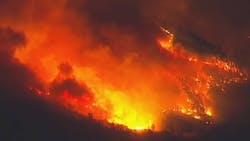CA Crews Find Ways to Battle Wildfires Without Power
Dealing with a wildfire is not easy. Dealing with a wildfire when PG&E turns off the power can be downright difficult.
When flames began racing through the hills of northeastern Sonoma County on Wednesday night, residents trying to flee the blaze, as well as firefighters battling it, also confronted the problem of darkness because of power cuts made to prevent fires from starting in the first place.
RELATED:
Evacuees in the area of the Kincade Fire reported not being able to turn on computers for information or locate personal items in the dark. Others said they didn’t receive emergency alerts, perhaps because they couldn’t charge their cell phones.
“I mean, it’s terrible,” said Geyserville resident Madonna Tavares, whose husband, Victor, couldn’t find his phone when they were forced to leave Thursday morning as the fire spread above town. “You know it’s your house, but you cannot see.”
The difficult combination of wildfires and power outages is likely to become more frequent as Pacific Gas and Electric Co. increasingly shuts off electricity to prevent fires. And state fire officials suggest being prepared.
“Just down to having a sturdy pair of shoes by your bedside helps,” said CAL FIRE spokesman Scott McLean. “And knowing where your car keys are, and what about having a cell phone battery block? There are little things that the public can do.”
Firefighters at the Kincade Fire didn’t report major problems with airplanes or ground crews attacking the fire because of the outage. The 10,000-acre blaze, which began about 9:25 p.m. Wednesday, was burning in sparsely populated hills and vineyards along Geysers Road at the edge of Geyserville. The cause remains under investigation.
PG&E began cutting electricity to homes and businesses in parts of Sonoma County, including where the Kincade Fire ignited, at 2 p.m. Wednesday because of forecasts for strong winds and warm temperatures. An estimated 27,837 customers in the county were subject to cuts. Similar hazard conditions are expected to return this weekend.
Fire officials acknowledged that power shut-offs make some of their suppression tactics more difficult and time-consuming, but they have contingencies.
For example, crews often draw water from wells or rural water systems fed by electrical pumps that sometimes don’t have backup power. In these cases, firefighters look for other water supplies or get portable pumps to tap the water.
“Electricity is a commodity,” McLean said. “It’s a nice thing for us to have, but we have other ways to get to the water.”
Phones, computers, batteries and other electrical equipment, used mainly for communication among firefighters, also are at the mercy of a robust power supply. But, again, crews compensate by carrying generators and charging gear.
In many big blazes, fire officials will ask power companies to cut the electricity so that downed wires and other equipment don’t pose a safety risk to firefighters and evacuees.
For sheriff’s deputies and local emergency officials, it was too early to gauge the impact of the preventive power outage on the evacuation. Three different types of electronic alerts were sent to people threatened by the Kincade Fire — text-message-style Wireless Emergency Alerts, SocoAlerts that generate texts, emails and calls to landline phones, and Nixle alerts that similarly reach out on multiple platforms.
Not knowing if these alerts were getting through, however, county officials also blasted sirens and went door to door to warn people of the fire.
“We make sure people are notified,” said Sgt. Juan Valencia with the Sonoma County Sheriff’s Office.
The relatively few number of homes at risk in the Kincade Fire simplified the evacuation effort. No injuries have been reported.
Gaylyn Maddox, who was in Healdsburg after evacuating, recalled a trying search for her rottweiler in the dark of her house. Maddox and her husband, Richard, had driven from their Alexander Valley Road home, leaving their dog, Dieter, behind. As the flames crept closer, they decided to return to rescue him.
“We could see the flames coming our way,” Maddox said.
With the electricity off, the couple moved around by the glow of camp lanterns. Dieter was happy to see them, even happier to head to safety.
“The air was choking,” Maddox said. “There were big pieces of ash coming down. Pieces the size of business cards.”
Since PG&E’s electrical equipment was blamed for 17 blazes in Northern California in October of 2017 — the month of the deadly Wine Country firestorm — the utility has been under pressure to find ways to keep the grid safe.
PG&E officials have said that they expect to continue preemptive power shut-offs for several years to ensure their equipment doesn’t spark a fire. The effort to make more permanent safeguards, like undergrounding lines and fire-proofing poles, is expected to take decades.
Gov. Gavin Newsom on Thursday expressed concern about the power outages affecting the work of emergency officials. In a letter sent to PG&E and the state’s other two investor-owned utilities, he said the shutoffs have “undermined efforts to coordinate with first responders to protect public safety.” Newsom urged better coordination.
While PG&E has received the state’s blessing for turning off power for safety purposes, the governor and Legislature are discussing putting more conditions on the practice.
San Francisco Chronicle staff writer Steve Rubenstein contributed to this story.
———
©2019 the San Francisco Chronicle
Visit the San Francisco Chronicle at www.sfchronicle.com
Distributed by Tribune Content Agency, LLC.
